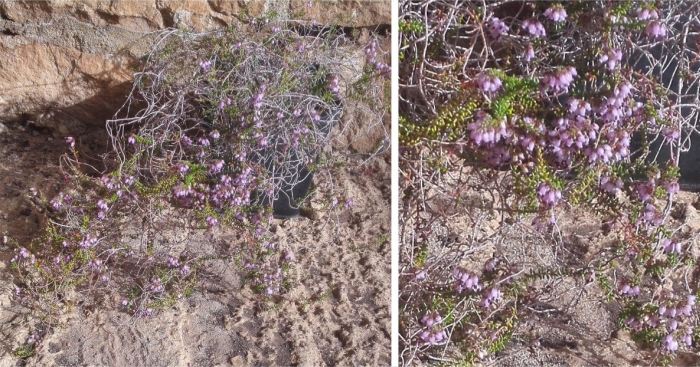Erica vernicosa
Erica vernicosa E.G.H.Oliv.
Family: Ericaceae
Common names: varnished heath (Eng.), vernisteheid (Afr.)
Introduction
This shrublet produces numerous, tiny, purplish-pink flowers from late summer till winter (mid-February to June) and makes a rewarding container plant.

Description
Description
Erica vernicosa is a low growing, spreading, evergreen shrublet and grows up to 100 mm high. It forms main branches which grow flat, near the ground, and often develop roots. Secondary upright branchlets emerge from the main branches and can grow up to ± 200 mm long.
The 3-nate leaves are elliptic to lanceolate and abaxially (away from the axis) rounded with no distinct edges. The small, shiny and sticky, 3-nate flowers, with 4 exserted stamens, appear in 1 or 2 whorls at the ends of secondary and tertiary branchlets. The flowers take an umbel-like shape when appearing in 2 whorls. The tiny seed, which is ± 1.2 × 1.1 mm, takes the form of an indehiscent fruit.

Conservation Status
Status
Erica vernicosa is not threatened, it has a conservation status of Least Concern (LC).
Distribution and habitat
Distribution description
This plant is a South African endemic and is quite commonly found on sandy limestone soils of De Hoop, in the Western Cape. It has a low-growing, spreading habit and can cover large open ground areas between shrubs such as proteas and restios. Plants growing on more rocky parts of hills tends to grow upright to at least 500 mm tall.
Derivation of name and historical aspects
History
The genus name Erica is derived from the Greek word ereiko, which means ‘to break’, this could refer to the stem of the plant that breaks or tears easily due to excessive wind or when not carefully handled. It is interesting to note that the Latin word for heath or broom is ereiko, and ericas are commonly referred to as heaths. The specific epithet vernicosa is Latin and means ‘varnished’ and refers to the fact that the flowers are coated with a sticky shiny layer.
Ecology
Ecology
This plant was observed to be pollinated by insects, they play a major role in carrying out the pollination process. The small seeds of heaths can remain viable for long periods in the soil bank, they will germinate when conditions become favourable.

Uses
Use
Erica vernicosa flowers over a long period and is quite an attractive species that grows well in a container. This plant also makes an excellent companion plant when planted in garden beds with other fynbos species such as those in the Restionaceae, Proteaceae and the Rutaceae families.
Growing Erica vernicosa
Grow
Erica vernicosa grows well in soil with a pH ranging from 5.5-6.7 and prefers a sunny position away from direct wind. Regular pruning and feeding with an organic liquid fertilizer will encourage new growth and flowering.
Take cuttings 2 months after flowering, take heel or nodal cuttings from semi-hard wood. Trials have shown that cuttings made ± 40–50 mm in size root best when a rooting hormone for semi hard wood cuttings is applied. Use a rooting medium made up of 50% fine-milled bark and 50% polystyrene chips for the cuttings. Ideal conditions to propagate this plant successfully requires a constant bottom heat of 24°C and regular misting of the cuttings at least every 10 minutes. Plant the cuttings into small pots when rooted, in a soil mixture of 8 parts bark and 3 parts sand, water well. Apply an organic liquid fertiliser every 2 weeks. It will take ± 3 months for the cuttings to be ready for planting out.
Sow seeds in the cooler months of the year, around April and May when the temperature naturally starts to drop. Use seed trays about a 100 mm deep, filled with equal parts of river sand and sifted composted bark. Place a thin layer of chipped stones in the bottom of the seed tray to allow for good drainage. Mix the small seeds with fine river sand to allow for an even spread of the seeds. Place the trays in a warm and sheltered spot and keep the medium moist by watering with a fine hose. The seeds will start to germinate within ± 2 months. The seedlings can be successfully planted out once they reach 10 mm height.
Ericas are not much prone to attacks by pests, therefore preventative measures such as not to sow seeds too dense and to maintain good air circulation can prevent fungal attacks. Thrips and cutworm can be easily controlled by applying an appropriate product and by following application directions carefully.
References
- Goldblatt, P. & Manning, J. 2000. Cape Plants. A conspectus of the Cape flora of South Africa. Strelitzia 9. National Botanical Institute, Pretoria & Missouri Botanical Garden, Missouri.
- Kamundi, D.A. & Victor, J.E. 2006. Erica vernicosa E.G.H.Oliv. National Assessment: Red List of South African Plants version 2020.1. Accessed on 2021/10/29
- Oliver, EGH. 2000. Systematics of Ericeae (Ericaceae-Ericoideae): species with indehiscent and partially dehiscent fruits. Contributions from the Bolus Herbarium 19: 3–472.
- Pienaar, K. & Smith, G.F. 2011. The southern African what flower is that? An essential guide to garden plants. Struik, Cape Town.
- Plants of the World online. Erica vernicosa E.G.H Oliv. https://powo.science.kew.org/taxon/urn:lsid:ipni.org:names:1017323-1#distribution-map. Accessed 06/04/2022.
Credits
Benjamin Festus
Kirstenbosch National Botanical Garden
May 2022
Plant Attributes:
Plant Type: Shrub
SA Distribution: Western Cape
Soil type: Sandy
Flowering season: Late Summer, Autumn, Winter
PH: Acid, Alkaline, Neutral
Flower colour: Purple, Pink
Aspect: Full Sun
Gardening skill: Average
Special Features:
Horticultural zones








Rate this article
Article well written and informative
Rate this plant
Is this an interesting plant?
Login to add your Comment
Back to topNot registered yet? Click here to register.